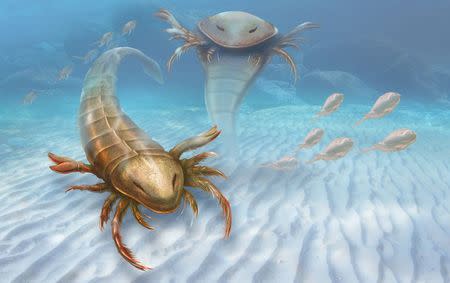Primordial sea beast resembled ancient Greek warship
By Will Dunham WASHINGTON (Reuters) - One of the earliest big predators to prowl Earth's primordial waters was a sea scorpion nearly 6 feet (1.7 meters) long whose body looked a bit like an ancient Greek warship. Scientists on Tuesday announced the discovery in northeastern Iowa of fossils of a large, active hunter called Pentecopterus decorahensis that lived 467 million years ago during the Ordovician Period. "Pentecopterus was an incredibly bizarre animal, with a long head that looked somewhat like the prow of a ship, a narrow body and massively enlarged limbs that it used to capture prey," Yale University paleontologist James Lamsdell said. "It would have been the largest predator in its environment and would have grabbed prey with its large, spiny legs and then pulled it towards its mouth," Lamsdell added. The fossils were exceptionally well preserved, showing fine details of its exoskeleton, and the scientists found remains of adult and juvenile Pentecopterus specimens. Pentecopterus was named after a type of galley used by the ancient Greeks known as a penteconter, which the creature resembles with its narrow body and long head, Lamsdell said. "You would not want one of these in your swimming pool," said Yale paleontologist Derek Briggs, another of the researchers. Pentecopterus is the earliest-known member of an extinct arthropod group called eurypterids that ranged from small scavengers to large apex predators and were important members of ancient marine ecosystems. They are most closely related to modern horseshoe crabs and terrestrial arachnids such as spiders and scorpions. The largest-known eurypterids exceeded 8 feet (2.5 meters) long. Eurypterids flourished until about 360 million years ago, when their numbers dwindled drastically, and finally went extinct about 254 million years ago, Lamsdell said. Pentecopterus is 10 million years older than a small, primitive eurypterid called Brachyopterus that previously had been the oldest-known member of the group. The researchers believe that sea scorpions even older than Pentecopterus are waiting to be unearthed. "It was a large predator and it's a relatively advanced, highly evolved form, indicating that sea scorpions had a significant earlier history of which we presently have no evidence," Briggs said. The Pentecopterus remains were found in an ancient meteorite impact crater more than 3-1/2 miles (nearly 6 km) in diameter by the Upper Iowa River and were excavated after the river was dammed temporarily. The research was published in the journal BMC Evolutionary Biology. (Reporting by Will Dunham; Editing by Mohammad Zargham)



